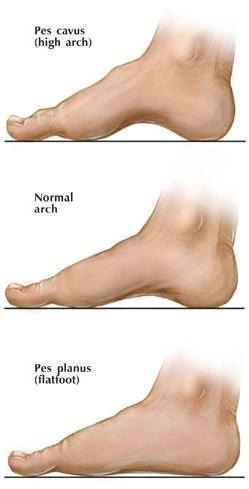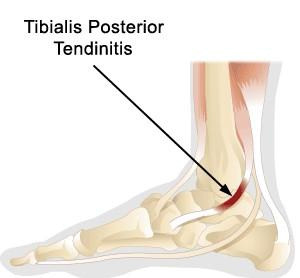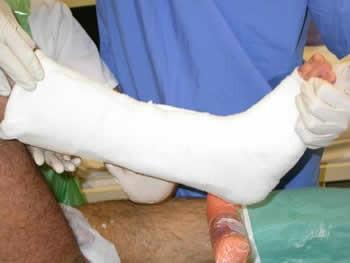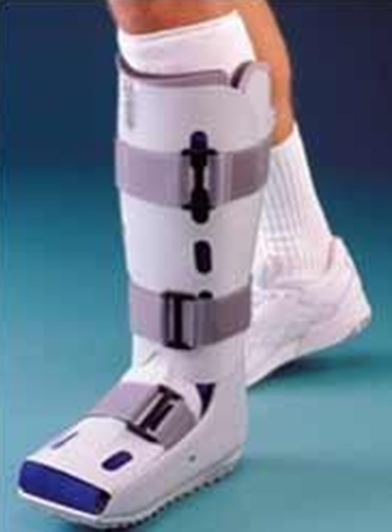 Most people’s feet have a space on the inner side where the bottom of the foot is off the ground (the “arch” of the foot). The height of this arch varies a lot from one person to another. People who have a low arch or no arch at all are said to have flat feet.
Most people’s feet have a space on the inner side where the bottom of the foot is off the ground (the “arch” of the foot). The height of this arch varies a lot from one person to another. People who have a low arch or no arch at all are said to have flat feet.
In many people, that is just the shape the foot is. It may run in the family, and both feet are usually much the same and reasonably supple. Occasionally a flat foot develops later in life. This most commonly is due to a problem with one of the major tendons of the foot (the tibialis posterior tendon).
The posterior tibial tendon runs behind the inside bump on the ankle (the medial malleolus), across the instep, and into the bottom of the foot. The main function of the tendon is to support the arch of the foot and so when it is damaged the foot flattens.
In the initial stages of damage, pain is felt along the length of the tendon, but as the tendon lengthens
deformity becomes apparent. At this stage
pain may develop on the outside of the ankle.
As time and deformity continues, the other joints in the hindfoot become affected and arthritic changes appear in the joints.
If the pain associated with these changes does not improve with simple measures such as shoe inserts and tablets, surgery is indicated to correct the deformity and prevent any long-term problems with the foot and ankle.
THE SURGERY
 The surgical treatment is complex and to some extent depends on the degree of damage. A cut is made on the inside of the ankle and the tendon itself is repaired. It always needs to be strengthened by using another tendon, usually the flexor digitorum longus. These tendons lie near the tibialis posterior at the ankle. Other tendons nearby do the same job, and so the tendon is not really missed when it is used.
The surgical treatment is complex and to some extent depends on the degree of damage. A cut is made on the inside of the ankle and the tendon itself is repaired. It always needs to be strengthened by using another tendon, usually the flexor digitorum longus. These tendons lie near the tibialis posterior at the ankle. Other tendons nearby do the same job, and so the tendon is not really missed when it is used.
Repairing the tendon alone is not sufficient and further bony surgical procedures must be carried out to support it as it heals. A ‘calcaneal osteotomy’ is typically performed via a mini- invasive (small-cut) technique, and this improves the shape of the foot.
In the first way a procedure is performed to move the heel bone towards the inside on the foot called a calcaneal osteotomy. This is the usual method . This bony surgical procedure is secured with one screw.
The cuts are stitched together using stitches and a plaster is applied to the leg.
HOW LONG WOULD I BE IN HOSPITAL?Most people who are reasonably fit can come into hospital on the day of surgery. After surgery your foot will tend to swell up quite a lot. You will therefore have to rest with your foot raised to help the swelling to go down. This may take anything from 24 hours to a week. If you get up too quickly this may cause problems with the healing of your foot. Once the swelling goes down and the cuts on your foot are healing you can get up with crutches and go home. The physiotherapist will teach you how to walk with crutches. Most people are in hospital for 2-3 days. |
WILL I HAVE TO GO TO SLEEP (GENERAL ANAESTHETIC)?The operation can be done under general anaesthetic (asleep). Alternatively, an injection in the back can be done to make the foot numb while the patient remains awake. Local anaesthetic injections do not always work and in that case you may have to go to sleep if the operation is to be done. The anaesthetist will advise you about the best choice of anaesthetic for you. In addition, local anaesthetic may be injected into your leg while you are asleep to reduce the pain after the operation even if you go to sleep for the surgery. You will also be given pain- killing tablets as required. This ‘nerve block’ typically lasts for 24-48 hours. It will remove pain, but also makes the foot numb and the toes immobile. Don’t be alarmed if you wake up after the operation with numb immobile toes. |
FOLLOWING YOUR SURGERY
-
ON THE WARD

A plaster splint down the back of your ankle and under your foot will be applied while you are asleep. This is only a half-plaster, to allow for swelling. You will be provided with crutches when you are discharged from hospital, and a physiotherapist will teach you how to use these.
-
WHEN YOU GO HOME
You cannot put any weight through your plaster in the first two weeks. You can usually take some weight for balance once the wounds are healing well and the swelling is going down – usually about 10-14 days. It is very important that the leg remains elevated most of the time in the first 2 weeks. Do not wet or remove the dressings.
It is normal to expect:
-
SWELLING – This can be minimised by elevating your foot above your heart
-
PAIN – You will receive a prescription for pain medication on discharge from hospital. Pain can also be minimised by elevating your leg.
-
BLEEDING – This always occurs. You may notice some oozing through the bandages.
You will need to wear a plaster or brace from your knee to your toes until the bones have healed – usually 6 weeks.
Further Appointments10-14 days after your operation you will be seen again by Dr. Sterling. Your plaster will be removed and the cut and swelling on your foot checked. If all is well you will be put into a walking boot. You should continue walking with your crutches. Non-weightbearing is continued About 6 weeks after your operation you will come back to for an x-ray. The bones are usually healed by this stage. You will then begin to weightbear in the boot, then eventually walk without it. You will be seen regularly for at least 6-9 months following the operation. It typically takes 12 months for the foot to fully recover following this surgery. |
HOW SOON CAN I….
-
WALK ON THE FOOT?
As explained above, you should not walk on the foot for about 6 weeks after surgery. Dr. Sterling will advise you when you can start taking some weight on the foot.
-
GO BACK TO WORK?
If your foot is comfortable, and you can keep your foot up, you can go back to work within 3-4 weeks of surgery. On the other hand, in a manual job with a lot of dirt or dust around and a lot of pressure on your foot, you may need to take anything up to 4+ months off work. How long you? are off will depend on where your job fits between these two extremes
-
DRIVE?
If you have only your left foot operated on and have an automatic car you can drive within a few weeks of the operation, when your foot is comfortable enough and you can bear weight through it. Most? people prefer to wait till the plaster is removed and they can wear a shoe.
-
PLAY SPORT?
After your splint/boot is removed you can start taking increasing exercise. Start with walking or cycling, building up to more vigorous exercise as comfort and flexibility permit. Impact type sports may not be possible after this type of surgery. The foot will be stiffer after surgery and you may not be able to do all you could before. However, many people find that because the foot is more comfortable than before surgery they can do more than they could before the operation. It typically takes 12 months to fully recover from this surgery.
IF YOU ARE CONCERNED:
|

